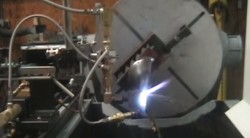Progressive Applications of Flame and Quench

This week we’re looking at the progressive flame hardening method. Progressive flame hardening features a specially designed flame head that includes both flame and quench. Heating and cooling both occur as the head or the part slowly moves across the area to be hardened. The design of the part determines whether the head or the part remains stationary. That versatility makes the process ideal for especially large parts weighing hundreds and even thousands of pounds, such as large rope drums and sheaves.
For example, a client we are working with needs to harden the rope groove of drums, some of which can be up to ten feet in diameter. In this case, we recommended a stationary flame head while rollers slowly rotate the drum through the heat/quench cycle. Once a full rotation is completed, the part is ready – no other heat treating is necessary.
Other kinds of parts that lend themselves to the scanning of progressive flame hardening are long, flat parts such as knives, rails, machine ways (for lathes, for example), vice bases, stamping dies, and turbine blades. Tooth-at-a-time hardening of gears also use the scanning method.
One important advantage of scanning the part during progressive flame hardening is that you don’t put a lot of heat into the part. That minimizes the risk of distortion. Also, once the scanning process is over, the part is done – there is no separate quench cycle. That can improve production efficiencies. Progressive flame hardening is best when trying to minimize distortion in parts that do not require hardness depths of greater than an eighth of an inch.
For example, a client asked us to help them solve problems of excessive distortion in their production of vise bases. They were running the bases through a furnace for hardening, but the amount of heat absorbed by the bases in the furnace caused excessive distortion. After testing they decided all they really needed to harden were the ways on the bases, making the furnace application unsuitable for such a localized hardness pattern. So they came to us looking for a method that would provide them with the required hardness pattern just where they needed it, and eliminating the excessive distortion. We designed a progressive flame hardening machine with movables flame heads that scanned the ways and solved the excessive distortion problem. (Link to picture Flame-Treating-Systems-Inc-Mission)
As with every method, progressive flame hardening has some challenges. These include maintaining heat and quench distances and flows so that temperatures remain constant over the entire treated surface. Progressive applications typically don’t require much depth of hardness: an eighth of an inch would be typical for 1045 and 4140 steels. Also when using progressive flame hardening, you can’t measure the part temperature with a standard pyrometer. We use special fiber optic cables inserted through the flame head to measure the heat. But even then we find that the best assurance of consistent temperature comes from operators who use the control panel to monitor coupling distance, flows and speed of travel during the process. All of our machines come with such controls to give as many avenues as possible for clients to ensure their process is to spec, each and every time.
Another application well suited to the progressive method is for complex and irregularly shaped parts. In some cases we have designed machines that move both the part and the flame heads to achieve consistent heat on irregularly shaped areas, such as with turbine blades. By following the contours of the rotating part, the heads could maintain the exact same coupling distance for the entire span. (Link to Progressive Flame Hardening Video)
As you might have guessed so far, flame head design is especially key to this method and is almost always a custom design. Heads can match any number of complex surface shapes. One example is a double sheave. The head must not only apply an even distribution of heat to both grooves, but also quench. (Link to DSCN112.jpg) Note the photograph of such a flame head. The water is distributed through the head to both sides, which are fed by the same torch. This was a cost-effective design that worked well on the double sheaves.
Next week we’ll wrap up this topic of flame hardening methods with a blog about the combination method. I’m always ready to talk to you about any heat treating question, and particularly if you are using or considering using flame hardening for your localized heat treating needs. Give me a call at 919-956-5208 or email mark@flametreatingsystems.com.
B18: We would like to know your opinion.






